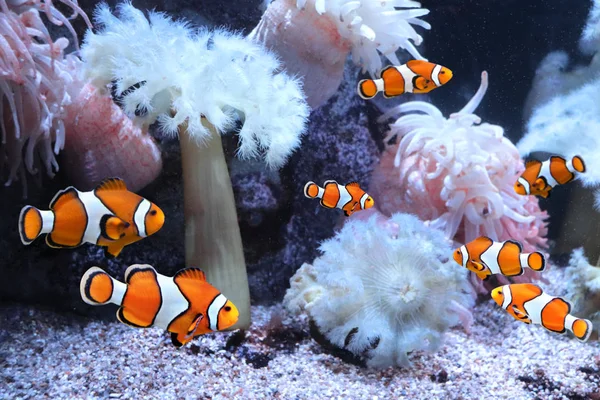We should probably be grateful to the film Finding Nemo for launching the popularity of the Clownfish into orbit. While this beautiful fish has always been popular with aquarium enthusiasts, Hollywood stardom has certainly made the Clownfish a finned superstar.
Clownfish are a favorite with hobbyists because of their striking, bright orange bodies, bold black and white stripes, and black-tipped fins. And yes, there’s something endearing about their faces.
Clownfish are a good choice for beginner hobbyists and are relatively easy to care for. If you’re thinking about adding Clownfish to your aquarium, you’ll also want to know how long they live. So, how long do clownfish live?
In this article, we’ll talk about the lifespan of the Clownfish and how to provide them with the longest and healthiest lives.
A Quick Clownfish Overview

Clownfish, also known as anemonefish, originated from the Amphiprioninae family of Pomacentridae. It has over thirty different species categories.
However, only one belongs to the Premas genus, with the remaining belonging to the Amphiprion genus. All the categories of clownfish have a symbiotic relationship with anemones and are often found swimming close to them.
Clownfish come in various shapes and colors depending on the species. They can reach an average length of 2 to 5 inches.
Clownfish Lifespan

How Long do Clownfish live?
If raised in an aquarium, the clownfish’s lifespan ranges from 4 to 10 years or up to 20 or more years depending on the quality of their habitat, diet, and care.
In their natural environment, Clownfish face more competition for food and threats from predators, so their lifespans average between 6 to 10 years.
Genetics
Genetics plays a major role in the health of your Clownfish. As with dogs and other animals, there are many new designer varieties of Clownfish introduced to the saltwater aquarium hobby. While it’s difficult to assess whether these “designer” fish are as hardy as natural Clownfish, they are typically bred more for appearance than health and hardiness.
Clownfish raised in captivity often have a longer lifespan than live caught fish because they haven’t been subjected to the stress of capture and transport. In other words, if you want to invest in the healthiest fish, do your homework and always ensure that you buy fish from a reputable breeder.
Environment
Native to the Indian Ocean, Clownfish feed on small creatures present in and around the anemone and algae. Anemones benefit from the essential nutrients found in poop excreted by the fish.

Clownfish are tropical fish sensitive to colder water, which means keeping them in a temperature range of 75-85 degrees Fahrenheit. Optimal tank size is 20-30 gallons, and for every Clownfish added to the tank, allow an extra 10 gallons. Even with proper filtration, regular water changes are important to maintain balanced levels. It’s always better to have a tank that’s too large rather than too small.
Clownfish should be kept in pairs or small groups as most creatures don’t thrive in solitary conditions. However, since Clownfish tend to grow from to 3-5 inches, it’s important to avoid overcrowding, which can cause ammonia poisoning and stress in smaller tanks. Also, if you plan to introduce multiple Clownfish, do so one fish at a time, as Clownfish don’t always get along with each other.
Do your research before mixing Clownfish with other fish. Some species may be incompatible because of temperament or because of water conditions, temperature tolerance, or food requirements.
Salinity in the tank should range between 1.020 – 1.024. You’ll need to balance the nitrites in the water and keep pH between 8.0 – 8.4. Invest in a good testing kit and test levels regularly.
You can also use water conditioners, salts, and similar products to keep the water properly balanced, or you can invest in a natural way to keep the tank clean by adding scavengers like snails and crabs.
Maintaining optimal tank conditions will ensure healthy fish and longer lifespans.
Diet
Proper nutrition is vital to ensuring the health and longevity of your Clownfish and maintaining their vivid colors.
Feeding should be daily if fish are small and 2-3 times daily for mature or juvenile fish. The best way to feed your fish is to spread the food and allow them to eat for 1-3 minutes, depending on the size of the fish.
Make sure to remove excess food to avoid fouling with water. Clownfish can live a week without food, so don’t overfeed. Since Clownfish are omnivorous, you can also mix multiple kinds of food to provide a balanced diet.
Diseases
Even with the best care, your Clownfish can sometimes contract a disease from bacteria in the water, live food, from other fish, or fights with other fish.
Keep an eye out for common diseases such as Fin Rot, White Spots, Hole-in-the-Head disease, and Swim Bladder Disorder. Some diseases are treatable with quarantining the sick fish, water changes, and medications, but some, like Hole-in-the-Head, require professional attention.
Lifespan Specifics of Clownfish

Researchers at the Scuola Normale Superiore in Pisa, Italy, in collaboration with the Leibniz Institute on Aging (FLI) in Jena, Germany, conducted research to reveal the secrets behind the clownfish’s longevity.
They found that modified proteins are a major factor that determines the longevity of a Clownfish, but which can be influenced by the quality of care and whether they live in the ocean or in aquariums.
Conclusion
It’s no coincidence that interest has grown in Clownfish since Finding Nemo propelled the species to fame.
Clownfish are a beautiful addition to any saltwater aquarium and are relatively affordable that should provide years of enjoyment with proper care.
However, there are factors to consider as maintaining a saltwater tank can be more challenging than maintaining a freshwater tank.
Considering the beauty of Clownfish and the enjoyment they bring, the commitment is well worth it!
We hope this article has provided you with the information you need about making Clownfish part of your aquatic population.
Interesting Reading:

